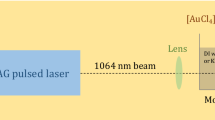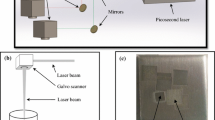Abstract
In this study, laser ablation of gold was performed in different ferric chloride solutions and water as a reference. The ferric chloride solutions included hexachloro iron(III) and aquachloro iron(III) having low and high hydrolysis degree. Transmission electron microscope (TEM) images showed spherical gold nanoparticles (GNPs) in water, particles which are strongly agglomerated with intimate contact at their interfaces in hexachloro iron(III) and individual separated particles with a halo of an iron component in aquachloro iron(III). In addition, no combination of Au and Fe was found in HAADF analysis or X-ray diffraction (XRD) patterns. In optical investigations, it was observed that gold nanoparticles made in hexachloro iron(III) solutions have localized surface plasmon resonance (LSPR) peaks broader than in the case of water that are quenched after a few hours, while ablation in the aquachloro iron(III) solution provides narrow LSPR absorption with a long-term stability. According to X-ray photoelectron spectroscopy (XPS) there are metallic Au and Fe2+ states in the drop-casted samples. By comparison of cyclic voltammetry of solutions before and after laser ablation, strong agglomeration in hexachloro iron(III) was attributed to the reducing role of iron(III) creating an unstable gold surface in the chloride solution. In aquachloro iron(III), however, the observed stability was attributed to the formation of the halo of an iron compound around the particles.






Similar content being viewed by others
References
P.K. Jain et al., Noble metals on the nanoscale: optical and photothermal properties and some applications in imaging, sensing, biology, and medicine. Acc. Chem. Res. 41(12), 1578–1586 (2008)
X. Sun, Y. Li, Colloidal carbon spheres and their core/shell structures with noble-metal nanoparticles. Angew. Chem. Int. Ed. 43(5), 597–601 (2004)
J. Bartolomé et al., Magnetic polarization of noble metals by Co nanoparticles in M-capped granular multilayers (M=Cu, Ag, and Au): an X-ray magnetic circular dichroism study. Phys. Rev. B—Condens. Matter Mater. Phys. 77(18), 184420 (2008)
N. Lopez et al., On the origin of the catalytic activity of gold nanoparticles for low-temperature CO oxidation. J. Catal. 223(1), 232–235 (2004)
C. Gutiérrez-Sánchez et al., Gold nanoparticles as electronic bridges for laccase-based biocathodes. J. Am. Chem. Soc. 134(41), 17212–17220 (2012)
J.P. Sylvestre et al., Femtosecond laser ablation of gold in water: Influence of the laser-produced plasma on the nanoparticle size distribution. Appl. Phys. A: Mater. Sci. Process. 80(4), 753–758 (2005)
H. Qian et al., Total structure determination of thiolate-protected Au38 nanoparticles. J. Am. Chem. Soc. 132(24), 8280–8281 (2010)
M.A. El-Sayed, Some interesting properties of metals confined in time and nanometer space of different shapes. Acc. Chem. Res. 34(4), 257–264 (2001)
M. Wang, D.-j.. Guo, H.-l.. Li, High activity of novel Pd/TiO2 nanotube catalysts for methanol electro-oxidation. J. Solid State Chem. 178(6), 1996–2000 (2005)
S.E. Skrabalak et al., Gold nanocages: synthesis, properties, and applications. Acc. Chem. Res. 41(12), 1587–1595 (2008)
M.C. Daniel, D. Astruc, Gold nanoparticles: assembly, supramolecular chemistry, quantum-size-related properties, and applications toward biology, catalysis, and nanotechnology. Chem. Rev. 104(1), 293–346 (2004)
Y. Sun, Y. Xia, Shape-controlled synthesis of gold and silver nanoparticles. Science 298(5601), 2176–2179 (2002)
Y.C. Cao, R. Jin, C.A. Mirkin, Nanoparticles with Raman spectroscopic fingerprints for DNA and RNA detection. Science 297(5586), 1536–1540 (2002)
P.L. Stiles et al., Surface-enhanced Raman spectroscopy, in Annual Review of Analytical Chemistry. 2008. pp. 601–626
J.N. Anker et al., Biosensing with plasmonic nanosensors. Nat. Mater. 7(6), 442–453 (2008)
S. Eustis, M.A. El-Sayed, Why gold nanoparticles are more precious than pretty gold: Noble metal surface plasmon resonance and its enhancement of the radiative and nonradiative properties of nanocrystals of different shapes. Chem. Soc. Rev. 35(3), 209–217 (2006)
X. Huang et al., Cancer cell imaging and photothermal therapy in the near-infrared region by using gold nanorods. J. Am. Chem. Soc. 128(6), 2115–2120 (2006)
E. Hutter, J.H. Fendler, Exploitation of localized surface plasmon resonance. Adv. Mater. 16(19), 1685–1706 (2004)
P.K. Jain et al., Calculated absorption and scattering properties of gold nanoparticles of different size, shape, and composition: Applications in biological imaging and biomedicine. J. Phys. Chem. B 110(14), 7238–7248 (2006)
K.L. Kelly et al., The optical properties of metal nanoparticles: the influence of size, shape, and dielectric environment. J. Phys. Chem. B 107(3), 668–677 (2003)
K.A. Willets, R.P. Van Duyne, Localized surface plasmon resonance spectroscopy and sensing, in Annual Review of Physical Chemistry. 2007. pp. 267–297
G.K. Darbha et al., Selective detection of mercury (II) ion using nonlinear optical properties of gold nanoparticles. J. Am. Chem. Soc. 130(25), 8038–8043 (2008)
Z. Li et al., From redox gating to quantized charging. J. Am. Chem. Soc. 132(23), 8187–8193 (2010)
H.L. Jiang et al., Synergistic catalysis of Au@Ag core-shell nanoparticles stabilized on metal-organic framework. J. Am. Chem. Soc. 133(5), 1304–1306 (2011)
R.W.J. Scott et al., Bimetallic palladium—Gold dendrimer-encapsulated catalysts. J. Am. Chem. Soc. 126(47), 15583–15591 (2004)
T. Shibata et al., Size-dependent spontaneous alloying of Au-Ag nanoparticles. J. Am. Chem. Soc. 124(40), 11989–11996 (2002)
J. Gao et al., Colloidal stability of gold nanoparticles modified with thiol compounds: bioconjugation and application in cancer cell imaging. Langmuir 28(9), 4464–4471 (2012)
J. Bao et al., Bifunctional Au-Fe3O4 nanoparticles for protein separation. ACS Nano 1(4), 293–298 (2007)
C.S. Levin et al., Magnetic–plasmonic core–shell nanoparticles. ACS nano 3(6), 1379–1388 (2009)
T.A. Larson et al., Hybrid plasmonic magnetic nanoparticles as molecular specific agents for MRI/optical imaging and photothermal therapy of cancer cells. Nanotechnology 18(32), 325101 (2007)
P.K. Jain et al., Surface plasmon resonance enhanced magneto-optics (SuPREMO): Faraday rotation enhancement in gold-coated iron oxide nanocrystals. Nano Lett. 9(4), 1644–1650 (2009)
F. Pineider et al., Spin-polarization transfer in colloidal magnetic-plasmonic au/iron oxide hetero-nanocrystals. ACS Nano 7(1), 857–866 (2013)
I. Mahapatra et al., Probabilistic modelling of prospective environmental concentrations of gold nanoparticles from medical applications as a basis for risk assessment. J. Nanobiotechnol. 13(1), (2015)
V. Amendola et al., Magneto-plasmonic Au-Fe alloy nanoparticles designed for multimodal SERS-MRI-CT imaging. Small 10(12), 2476–2486 (2014)
H. Gao et al., Plasmon-enhanced photocatalytic activity of iron oxide on gold nanopillars. ACS Nano 6(1), 234–240 (2011)
Z. Ban et al., The synthesis of core-shell iron@gold nanoparticles and their characterization. J. Mater. Chem. 15(43), 4660–4662 (2005)
B. Ravel, E. Carpenter, V. Harris, Oxidation of iron in iron/gold core/shell nanoparticles. J. Appl. Phys. 91(10), 8195–8197 (2002)
E.V. Shevchenko et al., Gold/iron oxide core/hollow-shell nanoparticles. Adv. Mater. 20(22), 4323–4329 (2008)
C.L. Ren et al., Facile method for preparing gold coated iron oxide nanoparticles. Mater. Res. Innov. 15(3), 208–211 (2011)
Z. Li, A. Friedrich, A. Taubert, Gold microcrystal synthesis via reduction of HAuCl4 by cellulose in the ionic liquid 1-butyl-3-methyl imidazolium chloride. J. Mater. Chem. 18(9), 1008–1014 (2008)
D. Shore et al., Electrodeposited Fe and Fe–Au nanowires as MRI contrast agents. Chem. Commun. 52, 12634–12637 (2016)
S. Scaramuzza, S. Agnoli, V. Amendola, Metastable alloy nanoparticles, metal-oxide nanocrescents and nanoshells generated by laser ablation in liquid solution: influence of the chemical environment on structure and composition. Phys. Chem. Chem. Phys. 17(42), 28076–28087 (2015)
P. Mukherjee et al., Formation of non-equilibrium Fe-Au solid solutions in nanoclusters. Appl. Phys. Lett. 102(24), 243103 (2013)
F. Mafuné et al., Formation of gold nanoparticles by laser ablation in aqueous solution of surfactant. J. Phys. Chem. B 105(22), 5114–5120 (2001)
T. Sakka et al., Laser ablation at solid-liquid interfaces: an approach from optical emission spectra. J. Chem. Phys. 112(19), 8645–8653 (2000)
S. Barcikowski, G. Compagnini, Advanced nanoparticle generation and excitation by lasers in liquids. Phys. Chem. Chem. Phys. 15(9), 3022–3026 (2013)
G. Compagnini, A.A. Scalisi, O. Puglisi, Ablation of noble metals in liquids: A method to obtain nanoparticles in a thin polymeric film. Phys. Chem. Chem. Phys. 4(12), 2787–2791 (2002)
S. Reich et al., Pulsed laser ablation in liquids: Impact of the bubble dynamics on particle formation. J. Colloid Interface Sci. 489, 106–113 (2017)
J. Zhang, C.Q. Lan, Nickel and cobalt nanoparticles produced by laser ablation of solids in organic solution. Mater. Lett. 62(10–11), 1521–1524 (2008)
J. Zhang, M. Chaker, D. Ma, Pulsed laser ablation based synthesis of colloidal metal nanoparticles for catalytic applications. J. Colloid Interface Sci. 489, 138–149 (2017)
V. Amendola, M. Meneghetti, Laser ablation synthesis in solution and size manipulation of noble metal nanoparticles. Phys. Chem. Chem. Phys. 11(20), 3805–3821 (2009)
G. Palazzo et al., On the stability of gold nanoparticles synthesized by laser ablation in liquids. J. Colloid Interface Sci. 489, 47–56 (2017)
V. Amendola et al., Formation of alloy nanoparticles by laser ablation of Au/Fe multilayer films in liquid environment. J. Colloid Interface Sci. 489, 18–27 (2017)
Z. Sheykhifard et al., Direct fabrication of Au/Pd(II) colloidal core-shell nanoparticles by pulsed laser ablation of gold in PdCl2 Solution. J. Phys. Chem. C 119(17), 9534–9542 (2015)
J. Liao et al., Linear aggregation of gold nanoparticles in ethanol. Colloids Surf., A 223(1–3), 177–183 (2003)
K.G. Moodley, M.J. Nicol, Kinetics of reduction of gold (III) by platinum (II) and iron (III) in aqueous chloride solutions. J. Chem. Soc., Dalton Trans. 10, 993–996 (1977)
A. Letzel et al., Size quenching during laser synthesis of colloids happens already in the vapor phase of the cavitation bubble. J. Phys. Chem. C 121(9), 5356–5365 (2017)
S. Petersen, S. Barcikowski, In situ bioconjugation: single step approach to tailored nanoparticle-bioconjugates by ultrashort pulsed laser ablation. Adv. Funct. Mater. 19(8), 1167–1172 (2009)
Author information
Authors and Affiliations
Corresponding author
Rights and permissions
About this article
Cite this article
Nouraddini, M.I., Ranjbar, M., Dobson, P.J. et al. Stabilized gold nanoparticles by laser ablation in ferric chloride solutions. Appl. Phys. A 123, 727 (2017). https://doi.org/10.1007/s00339-017-1346-y
Received:
Accepted:
Published:
DOI: https://doi.org/10.1007/s00339-017-1346-y




